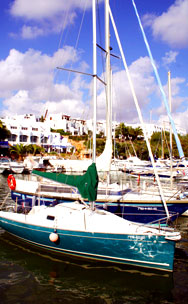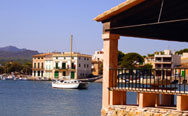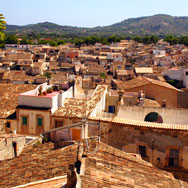- Villa search

- Canaries
- Caribbean
- Croatia, Bulgaria and Hungary
- Cyprus
- Florida
- France and Corsica
- Greece
- Italy
- Lakes and Mountains
- Madeira
- Malta and Gozo
- Portugal
- South Africa
- Spain - Balearics

Cala d’Or marina
Cala d’Or, by contrast, is a modern resort of whitewashed, low-rise buildings clustered around a series of narrow fjords, each with its own small beach. A favourite holiday spot for families because of its safe, sheltered bathing, the town has a busy pedestrianised centre which is packed with cafés, restaurants and tourist shops. There’s a more sophisticated atmosphere at the yacht marina where gleaming craft arrive from Gibraltar and Germany, Liverpool, Portsmouth and Chichester to moor along the narrow finger of water that leads to the yacht club. Lined with restaurants, the marina is a great place to eat al fresco as the sun goes down, the lights come on, and the quayside fills up with bronzed diners.
More authentically Spanish is Porto Colom, a short drive north along the coast. Reputedly the birthplace of Christopher Columbus – an honour it shares with several other Spanish ports – this small laid-back town is built around a large ‘inland’ harbour dotted with tethered craft and accessed through a narrow strait between tall cliffs. Popular with Spanish holidaymakers, it offers a choice of waterside restaurants, a small yacht marina and a quay of colourful painted houses.
Our party spent several happy hours on Cala Marcal beach on the south side of Porto Colom. Many of the east coast beaches are located at the back of narrow inlets and can get pretty packed in the peak season, especially in Cala d’Or, but Cala Marcal was broader and less crowded with the additional advantage of being just a five-minute drive from our villa.

Porto Collom
We also enjoyed Cala Sanau, a hidden bay reached down a narrow lane from the centre of S’Horta and particularly good for snorkelling. There are sun beds and brollies for hire here and cold drinks on sale at a tiny beach bar, but this quiet beach is tucked away from the usual tourist trail and is great if you’re happy with minimal amenities.
This stretch of coastline is studded with caves, several of which are open to the public, so we agreed on a family excursion to the Drac caves, half an hour’s drive away at Porto Cristo. It’s not an expensive outing, but neither is it an intimate one. Several hundred people are admitted every hour, on the hour, to walk along underground concrete paths and view the incredible floodlit formations – stalagmites, stalactites and subterranean pools – discovered in 1896 by a French caver 95 feet below the surface.
For a family not generally good at doing nothing, we found it surprisingly easy to do very little in such comfortable, peaceful surroundings
After the peace and quiet of our villa, we almost went into panic mode at the sight of so many people. The tour finishes in a huge underground auditorium where visitors file in to hear a short classical concert. A quartet is rowed across the subterranean lake in what looks like a scene from Phantom of the Opera, but the music wasn’t loud enough to drown the sounds of fractious children. We opted to walk out rather than prolong the agony. Great caves, just a shame about the theatricals.
Determined to discover a different side of the island, my husband and I left the youngsters by the pool and took an afternoon drive to Artá, a historic town in the north-east corner of the island. A tree-lined pedestrian street leads up to the Church of the Transfiguration, built in 1573 in Gothic style. The terrace outside the main entrance gives sweeping views over the terracotta rooftops, and it’s a welcome breather before embarking on what we instantly dubbed the Stairway to Heaven – a long flight of steps leads to the hilltop church of San Salvador, a 19th century neo-classical building housing a 13th century sculpture of the Virgin, one of the oldest on the island. From the crenellated ramparts surrounding the church, there are 360° views across the countryside and the coast.

Artá
Drive eastwards from Artá towards Cala Rajada and you’ll reach Capdepera, where a fortress spills down the hillside like a child’s model. Take the opposite direction and you skirt the broad bay of Alcúdia with its high-rise hotels but beautiful wide beaches, before crossing the headland into the more genteel bay of Pollença. We spent a pleasant day visiting a British friend with a holiday apartment just behind the Pine Walk, which hugs Port de Pollença’s pretty shoreline.
It took us just 75 minutes to drive home to our villa that evening, which proved that given enough time, we really could have taken in the whole island – if only we hadn’t been so comfortable where we were. If we’d had another week, we might well have ventured out to historic Palma, sampled picturesque Sóller, or perhaps dropped in at Valdemossa to compare villas with the Zeta Joneses. The boys might have had another round of golf at the glorious Vall d’Or club and we girls might have indulged in a little more retail therapy. But somehow I feel we might just have done a great deal more of nothing very much – and thoroughly enjoyed doing it.
Where we stayed
Villa Es Serral is a four-bedroom country house in four acres of private grounds and surrounded by almond and citrus groves. With views to the sea, it’s near Cala Sanau, one of Mallorca’s finest sandy coves, and the Vall d’Or golf course. For bookings or further information, telephone Mallorca Farmhouses on 0118 947 3001.
Read all about it
Mallorca – Car Tours and Walks by Valerie Crespi-Green
(Sunflower Books, £10.99).home | destinations and editorial | villa search | property for sale | car hire | flights | services
villaseek blog | contact villaseek | links and resources | advertise your villa© Dune Root Ltd and Villaseek.com 2012 - Caribbean
- Canaries